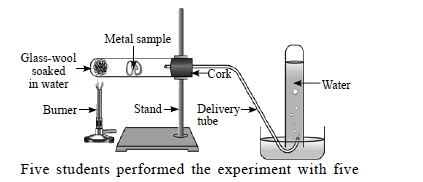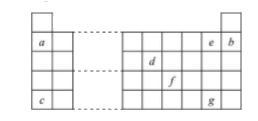Read the given passage and fill in the blanks by selecting an appropriate option.
Atomic numbers of elements P, Q, R and S are 3, 10, 12 and 20 respectively. Elements (i)––– belong to the same period while elements (ii)–––– belong to the same group. For cation formation, (iii)––––– loses electron from L-shell while (iv)–––– loses electrons from N-shell.
(i)(ii)(iii)(iv)Q,RP,SPS
(i)(ii)(iii)(iv)P,QR,SPS
(i)(ii)(iii)(iv)R,SQ,PRS
(i)(ii)(iii)(iv)P,RQ,SPS
The correct Answer is:B
To solve the question, we need to analyze the atomic numbers and electronic configurations of the elements P, Q, R, and S, which correspond to the following:
- Element P: Atomic number 3 (Lithium, Li)
- Element Q: Atomic number 10 (Neon, Ne)
- Element R: Atomic number 12 (Magnesium, Mg)
- Element S: Atomic number 20 (Calcium, Ca)
Now, let's fill in the blanks step by step.
Step 1: Identify elements in the same period
- P (Li): 1s² 2s¹ (2nd period)
- Q (Ne): 1s² 2s² 2p⁶ (2nd period)
- R (Mg): 1s² 2s² 2p⁶ 3s² (3rd period)
- S (Ca): 1s² 2s² 2p⁶ 3s² 3p⁶ 4s² (4th period)
Conclusion for (i): Elements P and Q belong to the same period (2nd period).
Step 2: Identify elements in the same group
- Group of P (Li): Group 1 (Alkali metals)
- Group of Q (Ne): Group 18 (Noble gases)
- Group of R (Mg): Group 2 (Alkaline earth metals)
- Group of S (Ca): Group 2 (Alkaline earth metals)
Conclusion for (ii): Elements R and S belong to the same group (Group 2).
Step 3: Determine which element loses an electron from the L-shell for cation formation
- P (Li): Has 1 electron in the 2nd shell (L-shell).
- Q (Ne): Full outer shell (not likely to lose electrons).
- R (Mg): Has 2 electrons in the 3rd shell (L-shell).
- S (Ca): Has 2 electrons in the 4th shell (not applicable for L-shell).
Conclusion for (iii): Element P (Li) loses an electron from the L-shell.
Step 4: Determine which element loses electrons from the N-shell
- P (Li): 2nd shell (not applicable).
- Q (Ne): 2nd shell (not applicable).
- R (Mg): 3rd shell (M-shell).
- S (Ca): 4th shell (N-shell).
Conclusion for (iv): Element S (Ca) loses electrons from the N-shell.
Final Answers:
1. (i) P and Q
2. (ii) R and S
3. (iii) P
4. (iv) S
- Element Q: Atomic number 10 (Neon, Ne)
- Element R: Atomic number 12 (Magnesium, Mg)
- Element S: Atomic number 20 (Calcium, Ca)
- P (Li): 1s² 2s¹ (2nd period)
- Q (Ne): 1s² 2s² 2p⁶ (2nd period)
- R (Mg): 1s² 2s² 2p⁶ 3s² (3rd period)
- S (Ca): 1s² 2s² 2p⁶ 3s² 3p⁶ 4s² (4th period)
- Group of P (Li): Group 1 (Alkali metals)
- Group of Q (Ne): Group 18 (Noble gases)
- Group of R (Mg): Group 2 (Alkaline earth metals)
- Group of S (Ca): Group 2 (Alkaline earth metals)
- P (Li): Has 1 electron in the 2nd shell (L-shell).
- Q (Ne): Full outer shell (not likely to lose electrons).
- R (Mg): Has 2 electrons in the 3rd shell (L-shell).
- S (Ca): Has 2 electrons in the 4th shell (not applicable for L-shell).
- P (Li): 2nd shell (not applicable).
- Q (Ne): 2nd shell (not applicable).
- R (Mg): 3rd shell (M-shell).
- S (Ca): 4th shell (N-shell).
1. (i) P and Q
2. (ii) R and S
3. (iii) P
4. (iv) S
Topper's Solved these Questions
- NSO QUESTION PAPER 2019 SET BBOOK - SCIENCE OLYMPIAD FOUNDATION CHAPTER - NSO QUESTION PAPER 2019 SET BEXERCISE - ACHIEVERS SECTION
2 Videos
- NSO QUESTION PAPER 2019 SET ABOOK - SCIENCE OLYMPIAD FOUNDATION CHAPTER - NSO QUESTION PAPER 2019 SET AEXERCISE - ACHIEVERS SECTIONS
1 Videos
- NSO QUESTION PAPER 2020 SET 1BOOK - SCIENCE OLYMPIAD FOUNDATION CHAPTER - NSO QUESTION PAPER 2020 SET 1EXERCISE - ACHIEVERS SECTION
2 Videos
Similar Questions
The given figure shows the most commonly employed method for the purification of metals.

When an aqueous solution containing ions of metal M is electrolysed .
View SolutionMs kanika, a class 10 teacher arranged the given set-up to study the reactions of different metals with steam .

Five students performed the experiment with five different samples of metals and noted their observations in the given table.

Who among these students recorded the correct observations?
View SolutionStudy the given part of the periodic table and select the correct statements. (Symbols do not represent the actual elements.)

I. a and c have same number of electron shells.
II. e and b have same number of outermost electrons.
III. d and fare metalloids.
IV. e and g have same number of valence electrons.
V. c and g will form an ionic compound.
VI. e is the most electronegative atom.
View SolutionConsider the following statements (i) - (iii), each with two blanks
(i) Pseudostratified epithelium lines the 1– tract while transitional epithelium lines the 2– tract
(ii) Lacunae of bones house 3– while lacunae of cartilage contain 4–
(iii) Tendon contain bundles of 5– fibres and rows of 6– cells between the them
Which one of the following options, gives the correct fill ups for the respective blank numbers from (1) to (6) in the statements ?
View SolutionSelect the option that correctly fills the blanks in the following statements. A. Glucose has ul((i)) carbon atoms, pyruvic acid has ul((ii)) carbon atoms and the acetyl group has ul((iii)) carbon atoms. B. Electrons enter the electron transport system as parts of hydrogen atoms attached to ul((i)) and ul((ii)) .
View SolutionThe atomic numbers of the three elements X,Y and Z are 2,6 and 10 respectively
(i) Which two elements belong to the same group?
(ii) Which two elements belong to the same period?
Given reasons for your choice.
View SolutionChoose from the following : ""_(20)Ca,""_(3)Li, ""_(11)Na, ""_(10)Ne (i) An element having two shells completely filled with electrons. (ii) Two elements belonging to the same group in the periodic table.
View Solution(a) How are the following related ? (i) Number of valence electrons of the different elements present in the same group. (ii) Number of the shells of the elements in the same period. (b) How do the following change ? (i) Number of shells of the elements as we go down a group. (ii) Number of valence electrons of elements on moving from left to right in a period. (iii)Atomic radius in moving from left to right along a period. (iv) Atomic size down a group.
View SolutionThe number of electrons in the valence shell of the atom of an element indicates the ____ to which the element belongs.
View Solution.nPr=∣n––∣n−r–––––––.∣r–– होता है |
View SolutionThere are 7 electrons in the outermost 'L' shell of an element. Predict the period and group in the periodic table this element belongs to.
View SolutionTwo elements 'P' and 'Q' belong to the same period of the modern periodic table and are in Group -1 and Group -2 respectively. Compare their following characteristics in tabular form:
(i) The number of electrons in their atoms
(ii) The sizes of their atoms
(iii) Their metallic characters
(iv) Their tendencies to lose electrons
(v) The formula of their oxides
(vi) The formula of their chlorides
View SolutionAn element has same number of electrons in I and IV shells and in the II and III shells
i] Write its electronic configuration
ii] Write the group and period it belong
iii] What is the valency of the element
View SolutionConsider the following statements (i) - (iii), each with two blanks
(i) Pseudostratified epithelium lines the 1– tract while transitional epithelium lines the 2– tract
(ii) Lacunae of bones house 3– while lacunae of cartilage contain 4–
(iii) Tendon contain bundles of 5– fibres and rows of 6– cells between the them
Which one of the following options, gives the correct fill ups for the respective blank numbers from (1) to (6) in the statements ?
View SolutionSelect the option that correctly fills the blanks in the following statements. A. Glucose has ul((i)) carbon atoms, pyruvic acid has ul((ii)) carbon atoms and the acetyl group has ul((iii)) carbon atoms. B. Electrons enter the electron transport system as parts of hydrogen atoms attached to ul((i)) and ul((ii)) .
View SolutionThere are three shells in the atom of element 'X', 6 electrons are present in its outermost shell.
In which period does this element belong?
View Solution
